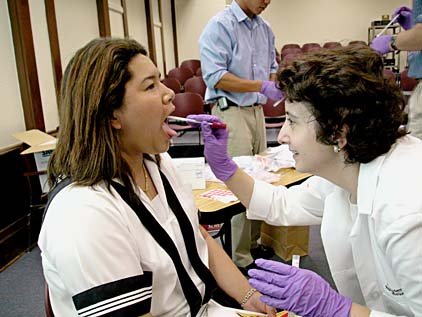
CRAIG T. KOJIMA / CKOJIMA@STARBULLETIN.COM
Dr. Guliz Erdem is trying to learn more about Group A Streptococci, the germ that causes strep throat and may lead to rheumatic fever. Erdem obtains a throat sample from Sacred Hearts Academy student Kristen Tom.
Study seeks cause
of rheumatic feverResearchers are trying to
find out why the disease's infection
rate is so high in Hawaii
Throat samples have been taken from nearly 1,000 public and private Hawaii school children in a study to understand why Hawaii has such a high rate of acute rheumatic fever.
"We are seeing 40 to 55 cases every year, important ones," said Dr. Guliz Erdem, University of Hawaii John A. Burns School of Medicine assistant professor of pediatrics working at Kapiolani Medical Center for Women and Children.
"This is about 20 times more than they are seeing on the mainland," said Erdem, pediatric infectious disease specialist.
He said mainland rates are about one patient per 100,000 population.
Erdem is studying Group A Streptococci (GAS) bacteria and risk factors associated with increased rates of acute rheumatic fever here. She's looking for the carrier traits.
"If it's not diagnosed early, it may cause heart failure and result in death," she said.
Patients with damaged heart valves from the fever later may require valve replacements, she said.
"It is a big public health burden for Hawaii."
GAS germs are commonly found in the throat and on the skin of people who may have no symptoms but can transmit the infection to others, Erdem said.
In the first 900 students tested, 30 had positive cultures, indicating they're carrying the bacteria, even though they have no symptoms, and they could be contagious, she said. Parents were notified to follow up with their physicians.
Most patients here with acute rheumatic fever are native Hawaiians and other Polynesians, Erdem said, "so it seems like there's a host factor. There must be something that makes these people prone to the disease."
Preliminary results suggest that might be true, she said.
She said the U.S. Centers for Disease Control has a database with more than 5,000 strains of GAS bacteria subdivided into 200 groups by using molecular techniques.
"We did several pilot studies and our results were really astonishing. We observed different types that they didn't observe on the mainland."
She said her team has identified more than 50 types of bacteria in Hawaii patients, including nine never seen on the mainland. Also, she hasn't found the types shown to cause acute rheumatic fever in temperate mainland areas, she said.
Erdem said this may suggest Hawaii is harboring different groups of bacteria that may be causing unusual patterns of the disease with severe skin infection clusters and significantly high skin-infection and acute rheumatic fever rates.
She has been swabbing school children because acute rheumatic fever is more common at those ages.
She finished collecting throat samples this week at the Sacred Hearts Academy in Kaimuki with Louise Medina, program administrator of the Clinical Research Center of UH-Manoa and Kapiolani Health, and a study group of nurses, technicians and medical students.
"It was a little tingly," agreed 10th graders Samantha Makini and Kristen Tom, who said they understood what the throat swabs were for.
Makini said she's had strep throat.
"It was pretty bad. You can't swallow," she said.
The study team also has been to Damien Memorial High School, Moanalua Intermediate, Nanaikapono Elementary, Nanakuli High and Intermediate, Roosevelt High, Saint Louis School, St. Francis, Stevenson Middle and Waimanalo Elementary and Intermediate Schools. Only students with parental consent were swabbed.
Erdem said all the schools' principals, administrators, teachers, parents and students were "very supportive of our study."
The swabs were sent to a clinical microbiology laboratory for inoculation and testing and the cultures then sent to Erdem's lab at Leahi Hospital.
She works with Drs. Karen Yamaga and Lucienne Abe in the Tropical Medicine and Microbiology Division to type and test the bacteria for certain factors possibly responsible for invasive infection.
Strep throat and skin infections are the most common and mildest forms of GAS disease, but it may lead in some cases to scarlet fever, middle ear infections, kidney problems or rheumatic fever.
Erdem is studying patients with acute rheumatic fever, with skin infections and inflammation of the pharynx, which causes sore throat.
She's also investigating more severe, rare invasive Group A streptococci infections, such as necrotizing fascilitis or flesh-eating bacteria, an infection of tissues under the skin and of the muscles; infections resulting in shock because of poisons produced by the bacteria, and infections resulting in shock and deaths, meningitis and pneumonia.
Fewer than 5 percent of all people with streptococci strep throat end up getting rheumatic fever if they get treatment, Erdem said. Antibiotics usually are prescribed.
She said she sees patients from Guam and Saipan who may have been diagnosed late and arrive with damaged heart walls and other complications.
"I think we are lucky here because rheumatic fever shows itself three to four weeks after infection and probably all pediatricians and physicians in Hawaii are familiar with the disease and treat it early," she said.
Erdem's study was funded with grants from the National Institutes of Health's "Center of Clinical Research Excellence" and the American Heart Association. She just received notice of another NIH grant of $200,000 per year for five years.
